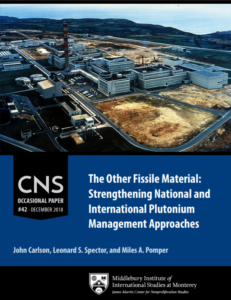December 7, 2018
John Carlson, Leonard S. Spector, and Miles A. Pomper
CNS Occasional Paper #42 discusses issues relating to separated, or unirradiated, plutonium in civilian nuclear programs, that is, plutonium that has been chemically separated from spent nuclear reactor fuel by reprocessing but has not been reintroduced into a nuclear reactor after separation and subjected to further irradiation.
Efforts to limit the spread of reprocessing in the civilian sector crystalized in the mid-1970s. Two developments triggered the intensified attention to this issue: (1) India’s 1974 test of a nuclear explosive device, which used as its core plutonium produced in an ostensibly peaceful nuclear-research program, and (2) attempts on the part of several states that had not renounced nuclear weapons to obtain reprocessing plants for their civil nuclear power programs.
In the intervening forty-four years, in those states that proceeded with civilian reprocessing programs, stocks of separated civilian plutonium have continued to grow in the aggregate. Taken together today, they are substantially greater than worldwide military plutonium stocks. Multiple approaches to limiting the separation of civil plutonium have been implemented, and still others have been given serious study, but stocks have increased regardless, while options for working down these stocks appear to be diminishing. Meanwhile, concern has deepened over the possible theft or diversion of this material, which could bring weapon-sufficient quantities of plutonium into the hands of violent extremists.
International Atomic Energy Agency safeguards are valuable, but they do not fully address the risks of breakout from nonproliferation or disarmament commitments. Safeguards are intended to provide timely warning of diversion, so as to provide an opportunity for intervention. However, even if diversion of plutonium is detected immediately, the plutonium could be weaponized too quickly for effective preventive measures. Nor are safeguards designed to address nuclear-material security issues. Accordingly, there is a need for institutional and technical measures to mitigate risks from separated plutonium.
This report recommends steps to address the risks posed by existing reprocessing programs and stocks as well as ways to discourage potential new programs.

